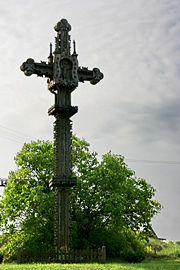
Kryždirbiai
Encyclopedia

Lithuanians
Lithuanians are the Baltic ethnic group native to Lithuania, where they number around 2,765,600 people. Another million or more make up the Lithuanian diaspora, largely found in countries such as the United States, Brazil, Canada, Colombia, Russia, United Kingdom and Ireland. Their native language...
art of crafting cross
Cross
A cross is a geometrical figure consisting of two lines or bars perpendicular to each other, dividing one or two of the lines in half. The lines usually run vertically and horizontally; if they run obliquely, the design is technically termed a saltire, although the arms of a saltire need not meet...
es. The making of altars and crosses is an important part of Lithuanian culture. Lithuanian traditional crosses are part of the people's Roman Catholic religion and are also linked to ancient pre-Christian culture
Lithuanian mythology
Lithuanian mythology is an example of Baltic mythology, developed by Lithuanians throughout the centuries.-History of scholarship:Surviving information about Baltic paganism in general is very sketchy and incomplete. As with most ancient Indo-European cultures Lithuanian mythology is an example of...
dating back much longer, having links to memorial poles signifying the pagan world tree
World tree
The world tree is a motif present in several religions and mythologies, particularly Indo-European religions, Siberian religions, and Native American religions. The world tree is represented as a colossal tree which supports the heavens, thereby connecting the heavens, the earth, and, through its...
. Approximately since Lithuania became a part of the Russian Empire
Russian Empire
The Russian Empire was a state that existed from 1721 until the Russian Revolution of 1917. It was the successor to the Tsardom of Russia and the predecessor of the Soviet Union...
in the 19th century, these crosses have become a symbol of the Lithuanian people.
The crosses are intricately carved of oak wood, and sometimes incorporate iron elements as well. Their craftsmen, known as kryždirbiai, travel across the country. The most renowned Lithuanian cross crafter and god carver
Dievdirbiai
Dievdirbys are Lithuanian wood carvers who create statues of Jesus and the Christian saints...
is the self-taught Vincas Svirskis (1835–1916), whose crosses, once seen across central Lithuania, are now kept in national museums.
The stylized crosses, Lietuviškasis kryžius, are put up along roadsides, in cemeteries, near houses, and as votive offerings in churches. The crosses combine elements of architecture, sculpture, blacksmith art, and painting. One to five meters high, they often feature floral or geometric symbols, motifs of the sun, birds, and the tree of life; they are sometimes adorned with small statues. To plead for grace or to express gratitude, the crosses are built as memorials to the dead or as the signs of spiritual protection at certain places. Even today crosses are built to mark the places of former settlements or farmsteads, places of death by homicide or accident, in memory of deceased people or groups of people, significant events and anniversaries, as a protection for road travelers and adornment of sacred sites. The Hill of Crosses
Hill of Crosses
The Hill of Crosses is a site of pilgrimage about 12 km north of the city of Šiauliai, in northern Lithuania. The precise origin of the practice of leaving crosses on the hill is uncertain, but it is believed that the first crosses were placed on the former Jurgaičiai or Domantai hill fort after...
holds a large collection of the pieces.
Lithuanian cross crafting has been enrolled into the list of Masterpieces of the Oral and Intangible Heritage of Humanity
Masterpieces of the Oral and Intangible Heritage of Humanity
The Proclamation of Masterpieces of the Oral and Intangible Heritage of Humanity was made by the Director-General of UNESCO starting in 2001 to raise awareness on intangible cultural heritage and encourage local communities to protect them and the local people who sustain these forms of cultural...
of 2001 by UNESCO
UNESCO
The United Nations Educational, Scientific and Cultural Organization is a specialized agency of the United Nations...
.
Intricate cross crafting of wood, stone or metal, as well as elaborate jewelry crosses is known in other cultures as well. Examples are Celtic cross
Celtic cross
A Celtic cross is a symbol that combines a cross with a ring surrounding the intersection. In the Celtic Christian world it was combined with the Christian cross and this design was often used for high crosses – a free-standing cross made of stone and often richly decorated...
es, Ethiopian cross
Ethiopian cross
Ethiopian crosses are symbols of Christianity in Ethiopia. Their elaborate, stylized design is markedly distinct from the similar European Christian crosses.-See also:*Lalibela Cross*Kryždirbystė, the Lithuanian art of wooden cross crafting...
es, and Armenian cross
Armenian Cross
An Armenian cross is a symbol that combines a cross with a floral postament or elements. In the Armenian Christianity it was combined with the Christian cross and this design was often used for high crosses – a free-standing cross made of stone and often richly decorated.- External links :* * * * *...
es.

